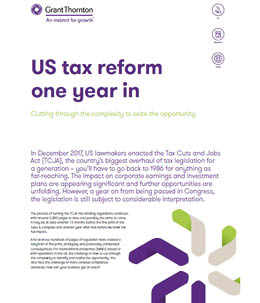-
Transactional advisory services
Find out more about the transactional advisory services of Grant Thornton Financial Advisory Services
-
Valuations
Find out more about the valuations services of Grant Thornton Financial Advisory Services
-
Mergers and acquisitions
Find out more about the merger and acquisition services of Grant Thornton Financial Advisory Services
-
Forensic and investigation services
Find out more about the forensic and investigation services of Grant Thornton Financial Advisory Services
-
Recovery & reorganisation
Find out more about the Recovery & reorganisation services of Grant Thornton Financial Advisory Services
-
Business risk services
Find out more about the business risk services of Grant Thornton Financial Advisory Services
-
Business consulting
Find out more about the business consulting services of Grant Thornton Financial Advisory Services
-
Capital market
Capital market
-
Corporate and business tax
Find out more about our corporate and business tax services.
-
Direct international tax
Find out more about our direct international tax services.
-
Global mobility services
Find out more about our global mobility services.
-
Indirect international tax
Find out more about our indirect international tax services.
-
Transfer pricing
Find out more about our transfer pricing services.
-
Litigation
Our lawyers and accountants can manage all defense measures provided not only by the Italian law, but also by EU regulations and conventions
-
Family business
Find out more about our Family business services.
-
Legal
The client can be assisted in every need and with the same care both on important operations or disputes and on simple matters

-
Back office outsourcing
Find out more about our Back office outsourcing services
-
Business process outsourcing
Find out more about our business process outsourcing services.
-
Compilation of financial statements
Find out more about our compilation of financial statements services.
-
Tax compliance
Find out more about our tax compliance services.
-
Electronic invoicing
Find out more about our electronic invoicing services
-
Electronic storage
Electronic storage is an archiving procedure that guarantees the legal validity of a digitally stored electronic document
-
Revaluation of corporate assets
Find out your civil and fiscal revaluation of tangible, intangible and financial assets
-
Payroll
Complete and customized payroll service, integrated with digital solutions and compliant with Italian and international regulations.
-
Labor consultancy
We help Italian and international companies manage all aspects of their workforce.
-
HR & Payroll Advisory Services
We review contracts, payroll, and risks for extraordinary transactions and we assess tax, labor, and safety risks in outsourcing contracts.
-
Extended services
We provide integrated digital tools to simplify HR management.
-
HR Infinity Portal
The HR Infinity Portal is Zucchetti’s platform designed to centralize communication between the company and its employees.
-
Cybersecurity
GT Digital helps clients structure information security management internal functions, also through partially or totally outsourced functions
-
Agile and Programme Management
GT Digital provides support in the adoption and implementation of different portfolio management
-
Robotic Process Automation
Our “BOT Farm” can rely on digital workers able to help clients in routine activities, allowing employees to deal with more added-value activities
-
Data strategy and management
GT Digital can support clients in seizing the opportunities offered by Big Data, from the definition of strategies to the implementation of systems
-
Enterprise Resource Planning
We support clients in selecting the most appropriate ERP System according to their specific needs, helping them also understand licensing models
-
IT strategy
GT Digital supports clients in making strategic choices, identifying innovation opportunities, comparing themselves with competitors
-
IT service management
We can support with software selection and with the implementation of dedicated tools for the management of ICT processes
-
DORA and NIS 2
The entry into force of the DORA Regulation and NIS2 represents a major step towards the creation of a harmonised regulatory framework
In December 2017, US lawmakers enacted the Tax Cuts and Jobs Act (TCJA), the country’s biggest overhaul of tax legislation for a generation – you’ll have to go back to 1986 for anything as far-reaching. The impact on corporate earnings and investment plans are appearing significant and further opportunities are unfolding. However, a year on from being passed in Congress, the legislation is still subject to considerable interpretation.
Far reaching tax reform
By any measure, the TCJA is a game-changer. The impact reaches beyond tax management to business planning, operating structures and market competition.
The headline shift is the reduction in the US federal corporate tax rate from 35% to 21%. While this monumental cut makes the US rate more competitive, it by no means makes it the lowest in the G7. Moreover, the TCJA closes a number of exemptions, which may mean that the gain isn’t quite as big as the 14% cut would imply.
Just as far-reaching is bringing the US’ international tax regime broadly into line with other major economies. Having now moved to a ‘quasi-territorial’ system, in which tax is paid where the money is made subject to some guardrails to prevent abuse. This levels the playing field with major international competitors.
The TCJA has given corporations an opportunity to repatriate funds held abroad free of future US tax (after a transition ‘toll tax’ payment). Further relief comes from a ‘participation exemption’ on tax on dividend income from foreign subsidiaries. While such an exemption is another move towards the international centre of gravity of taxation, the US qualification threshold of a 10% stake is noticeably lower than the standard 25%.
Global Intangible Low-Taxed Income (GILTI)
The main counterweight to the territorial system is the GILTI, which is an anti-deferral measure designed to prevent companies from shifting profits on mobile income (eg royalty payments) to low tax jurisdictions by imposing a 13.125% tax floor on tax paid outside the US.
The concept of a minimum tax can also be seen in the Base Erosion Anti-Abuse Tax (BEAT), which seeks to deter corporations from making excessive tax-deductible expense payments to foreign affiliates. BEAT has significant implications for transfer pricing, with the risk of double taxation heightened by the lack of a credit for tax paid outside the US on these payments.
Has the reform delivered its objectives?
As well as simplify the tax system, the TCJA is designed to boost the US economy and encourage the creation of high paid jobs.
There is little sign of a simplified tax system; further grey areas and multi-step calculations by imposing one set of highly complex legislation on an already complex set of tax statutes.
There have been positive signs on the economy. How much of this is down to the tax cuts and whether the gains are sustainable are hard to gauge with any certainty at this stage. What is not in doubt is that a $1.5 trillion tax cut gives US corporations a significant edge when competing with MNEs from other jurisdictions.
Time to capitalise on the potential opportunities?
We see that there are four ways you can get to grips with the changes:
Update your tax model:
The way your entities, transfer pricing and cost-sharing arrangements have been structured from a tax perspective are likely to reflect a system that has now been superseded. How does your operating structure now look from a tax efficiency perspective? Are you still getting the benefits you had before? How can you bring structures and supply chain arrangements up to date?
Re-evaluate capital structure:
We’re already seeing a greater willingness to deploy capital in the US in search of better returns. The flipside includes re-evaluating the use of debt in light of the limits on interest rate deductibility. For private equity, the treatment of certain leveraged structures may be potentially less favourable than before.
Moreover, while before, it was common practice to borrow money in the US and lend this to the rest of the group, the tighter deductibility criteria could mean that it makes more sense to access credit outside the US. The shifting targets in this area are causing taxpayers to align borrowing with profit generating activities.
Make your voice count:
If the devil is in the detail, then it’s important to work out what proposed interpretations of the legislation mean for your business and have your say as part of the consultation process. This will be ongoing.
Work out how to manage the increased compliance demands
The TCJA imposes significant extra demands on data gathering, calculation and filing, much of which needs to be carried out quarterly. If we look at GILTI, for example, your business would need to carry out calculations and returns for every subsidiary. If the amount of information in a US tax return might have been 5-6 pages per entity, we are now typically looking at 12-15. Are your systems, processes and controls up to speed?
Gianni Bitetti, Partner at Bernoni Grant Thornton, commented: “The US tax reform, seen by many as one of the most significant reform of the American tax system over the last decades, led to the reduction of the US federal corporate tax rate from 35 to 21%, the transition to a so-called territorial tax system and other specific provision (such as limitations to the deductibility of interest payable or a threshold for the forwarding of tax losses). On the other hand, the reform provided for the cancellation of existing tax exemptions.
As a consequence, Italian companies operating in the US (through a subsidiary or a local branch) need to fully be aware of the scope of the reform and of its impacts on their business model, in terms of new opportunities or of a possible increased tax burden compared to previous years. In both cases, there are many elements to evaluate to ensure compliance with new tax regulations.”
On the front foot
The TCJA has the potential to deliver higher earnings and more cash for investment. Yet, there is a lot of hard work required to realise the benefits, along with systematic reviews of systems, technology and processes to ensure compliance.
Whether you’re a US-based MNE or you’re an MNE with operations in the US, it’s important to get on the front foot by assessing the impact on your structures and how you can manage this. It’s also important to look at the TCJA as part of a wider review of whether current tax management is fit for purpose, with the US reforms providing the catalyst for possible system modernisation.

